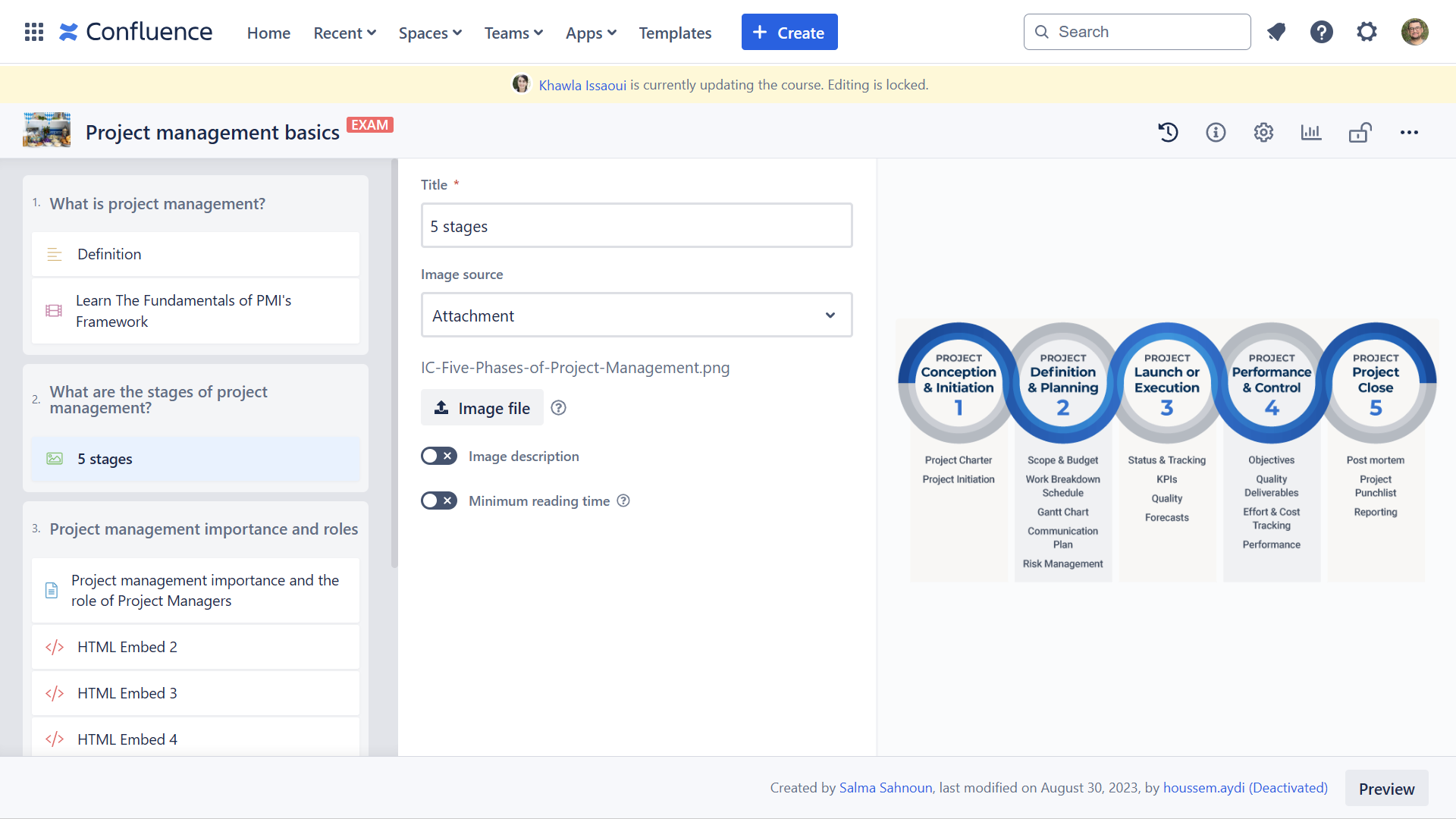Course configuration
Thumbnail

Upload an image as a thumbnail. This image is used in the course catalog. Using a rectangular image is preferred for better rendering.
New thumbnail uploads are limited to 2MB.
Multi-language
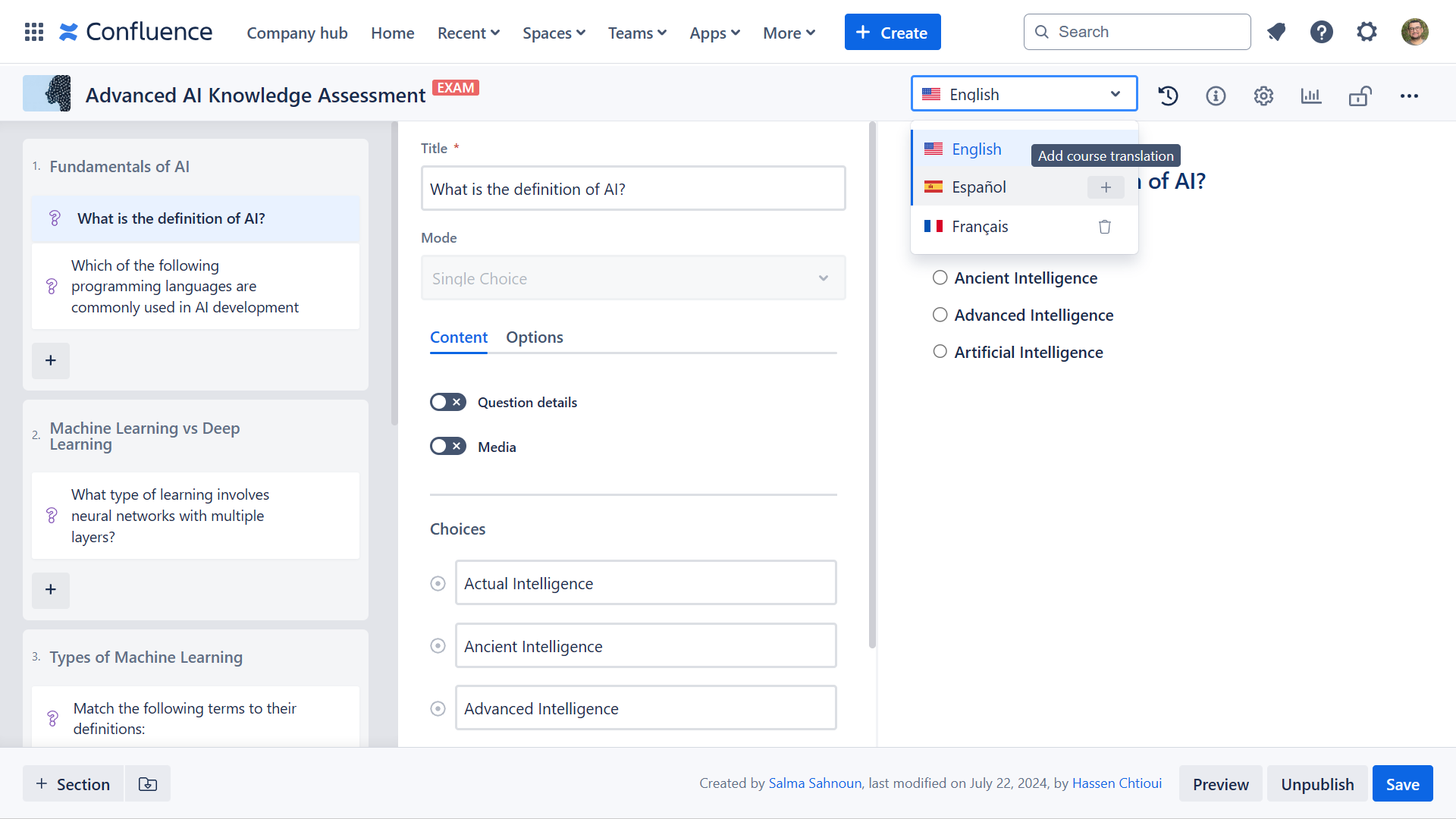
Once languages are selected in the global app configuration, you can add or delete course translations in these languages.
When a translation is created, the course title, description, custom dashboard message, thumbnail, section titles and component content can be customized for each language. Course configuration and component settings follow the default language settings.
Freetext and Fill in the blank question choices cannot be translated.
Red or yellow dots will appear next to the language filter to notify course editors of missing or outdated component translations.
CLOUD ONLY: If AI translation is enabled, the AI button will appear for translations and will allow you to translate the selected component or multiple components. Only component title, description and content will be translated by AI.
For text components, code snippet content will not be translated by AI.
Course history

This option gives the ability to restore a previous course version.
- Version mode: Click on the button to switch between the editing and versioning modes
- Version label
- Version number and version creator
- Version creation date: Switch between course versions using arrow buttons
- Restore button: Clicking on this button will allow you to go back to the editing mode
Only course content can be restored; course configuration is not included.
Old versions cannot be edited before restoring them. When an old version is restored, it will be saved as the latest version.
Configuration
Catalog
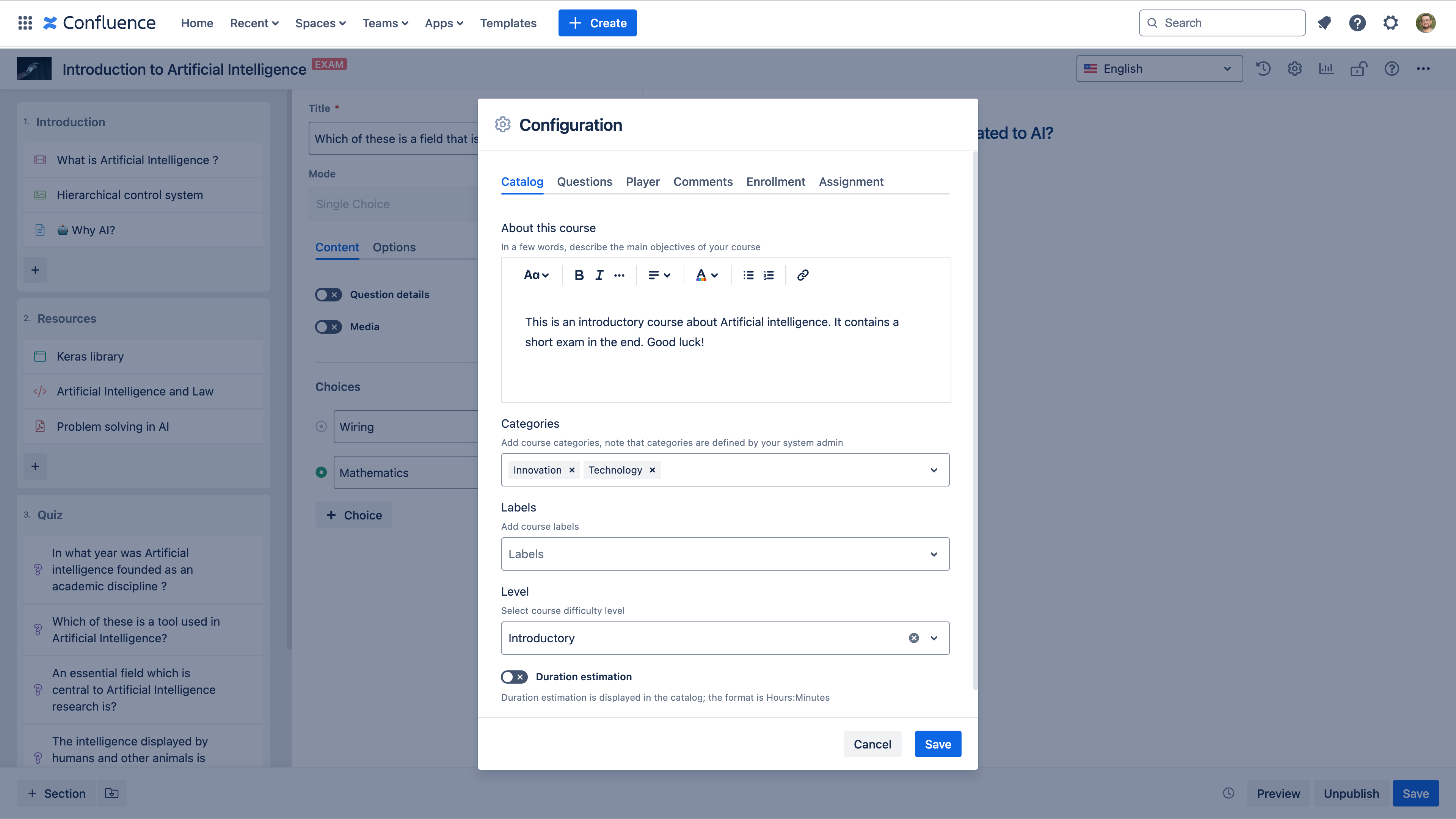
About this course
Fill in a quick description of the course as shown in the screenshot. This description will be directly visible on the course card, in the course catalog.
The maximum length of the course description is 1000 characters.
Categories
Select one or more course categories; Categories are used in the catalog to filter the courses.
A Smart Courses administrator can manage/ create categories from Smart Courses Configuration.
Labels
Select one or more labels of a course, the labels are used in the catalog to filter courses. You can also use these labels in the Confluence search to find courses. Check this link for more details about Confluence labels creation.
Smart Courses uses the native Confluence labels. If you create a new label, it will be available for pages and other content types in Confluence.
Level
Choose the difficulty level of a course:
- N/A
- Introductory
- Intermediate
- Advanced
These levels are also used in the catalog to filter courses.
Duration estimation
This will be displayed on the course card to inform the user of the estimated length of the course.
Questions

Exam mode
This mode determines whether a course is an Exam. Enabling the Exam mode is a strict mode that implies specific rules for playing courses and reporting:
a. Minimum pass score: The minimum pass score is the minimum required score to pass an exam. Scores are calculated based on the correct-answers rate.
For example, if the exam includes four questions, and the Minimum pass score is set at 50%, the learner has to answer a minimum of two correct answers to pass the exam.
This option is only available when exam mode is selected.
b. Maximum exam attempts: it is the number of attempts a learner has per exam. Learners are able to reset their sessions once an exam is finished if they still have remaining attempts.
An attempt is counted each time a learner finishes an exam. If, for example, this option is set to 3, and the learner finishes the exam, it will be possible to retake the exam when relaunching the course. Thus two remaining attempts are left.
Hide questions results
Question results will not be displayed to the learners once they submit their answers.
Hide overall questions results
Hide the overall score and question results to the learners at the end of the course session.
Hide expected options for wrong answers
Correct option(s) will not be displayed to the learners if the result is wrong.
Require course completion to view results
Require visiting all the course content to view results.
Player
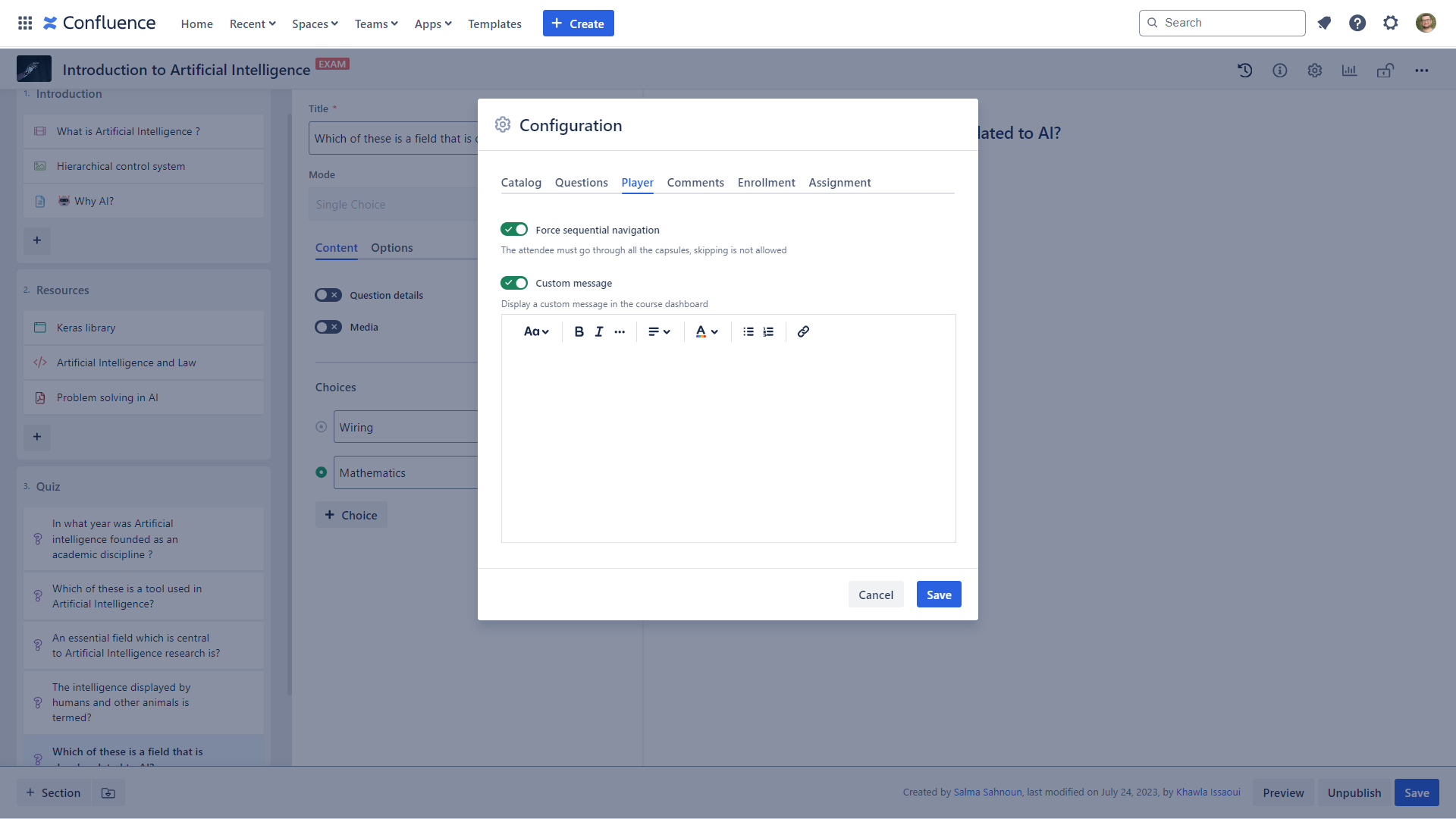
- Force sequential navigation: This option allows deactivating skipping components. The learner must go through all the components.
- Custom message: Add a customized message that will be displayed on the dashboard.
Prerequisites

Skills: Set the skills that learners must acquire to unlock this course.
You can add up to 5 skills as course prerequisites.
Skills cannot be added as prerequisites when the course is set as a requirement for any skill.
Comments
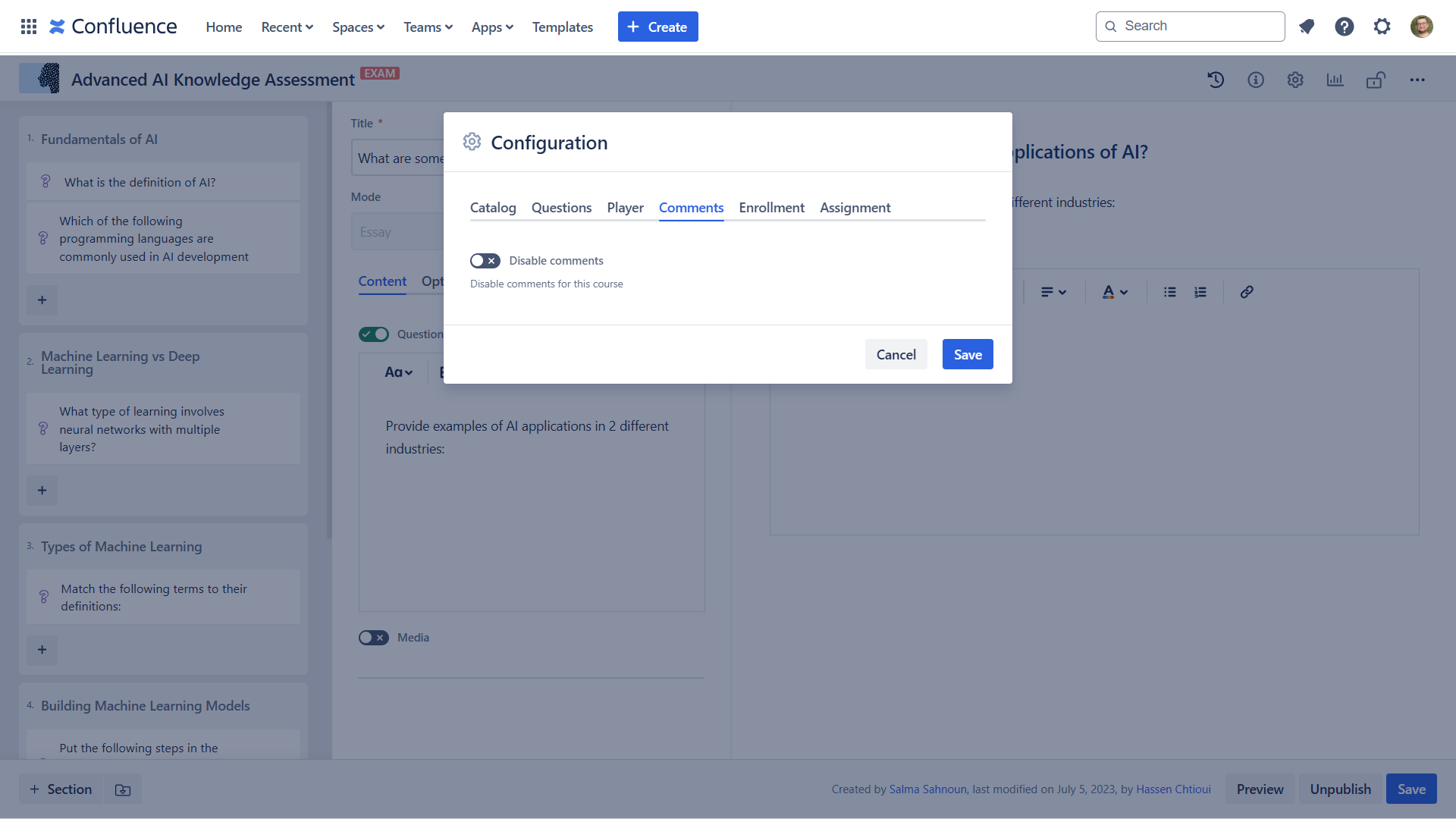
Disable comments for this course. Comments can also be disabled globally or per space.
Enrollment

- Allow contributors enrollment: Contributors will be allowed to have a course session, and their insights will be tracked similarly to other learners.
- Allow enrollment after the due date: Allow enrollment even if the assignment is overdue.
- Recurrent course: The course should be repeated periodically. Expired sessions will be reset when the learners revisit the course.
The "Allow contributors enrollment" is toggled by default for newly created courses.
CLOUD ONLY: Learners will get an email notification soon after their session in a recurrent course expires
Assignment
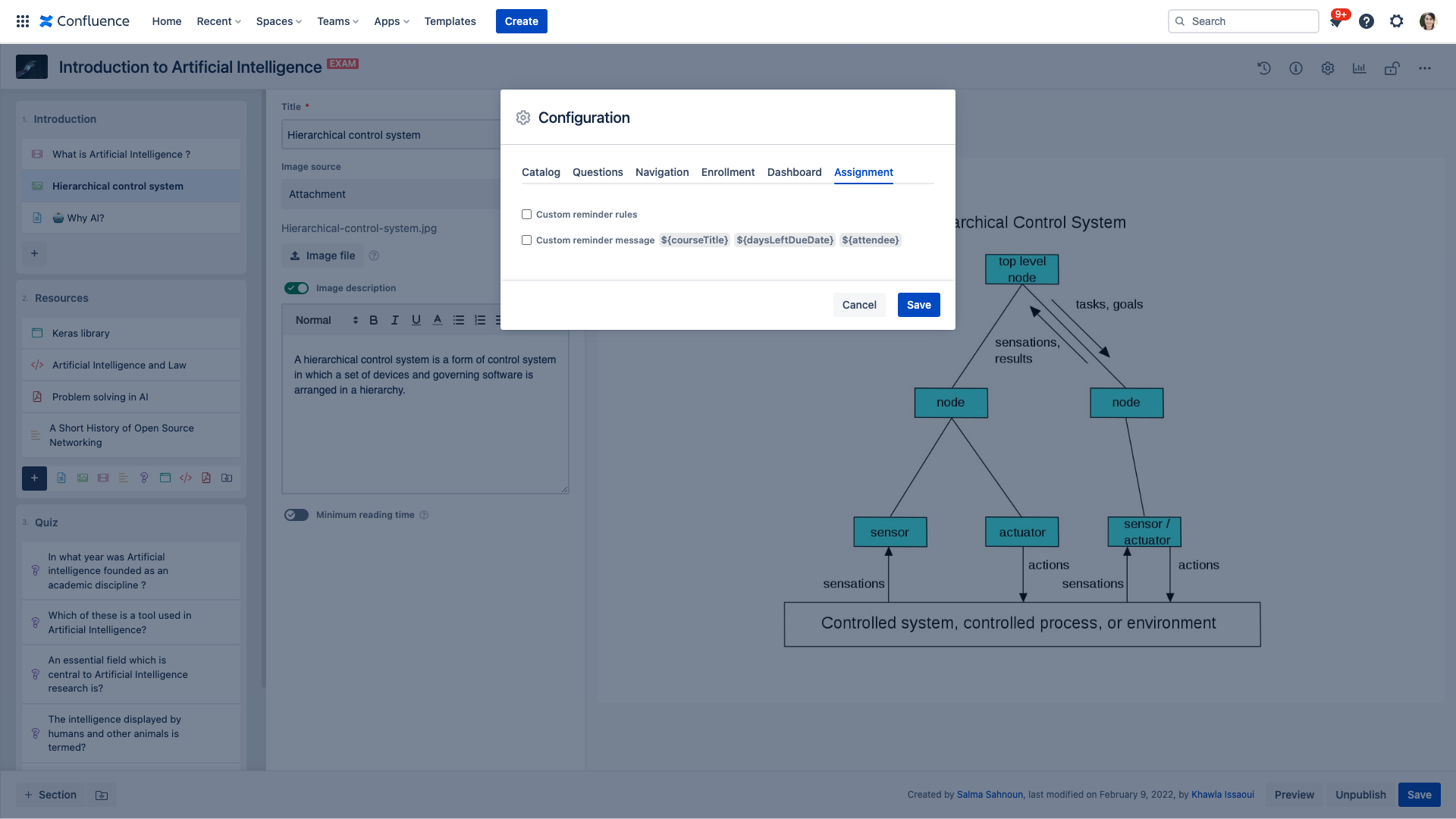
Customize assignment reminder rules and message for this course.
Here you can override the global customized assignment reminder and message.
Restrictions

This option allows defining course restrictions. By default, the course has the same accessibility rules as the space in which it was created. A course administrator can customize restriction rules.
These restrictions are exclusive and not inclusive; only the mentioned groups and users will see the course in the catalog and attend it.
You can add up to 100 individual users and 100 groups to the restricted list.
Actions

Share

Select a user or a group of users to invite them to attend the course.
Feedback [Cloud]
Browse and filter all course feedback.
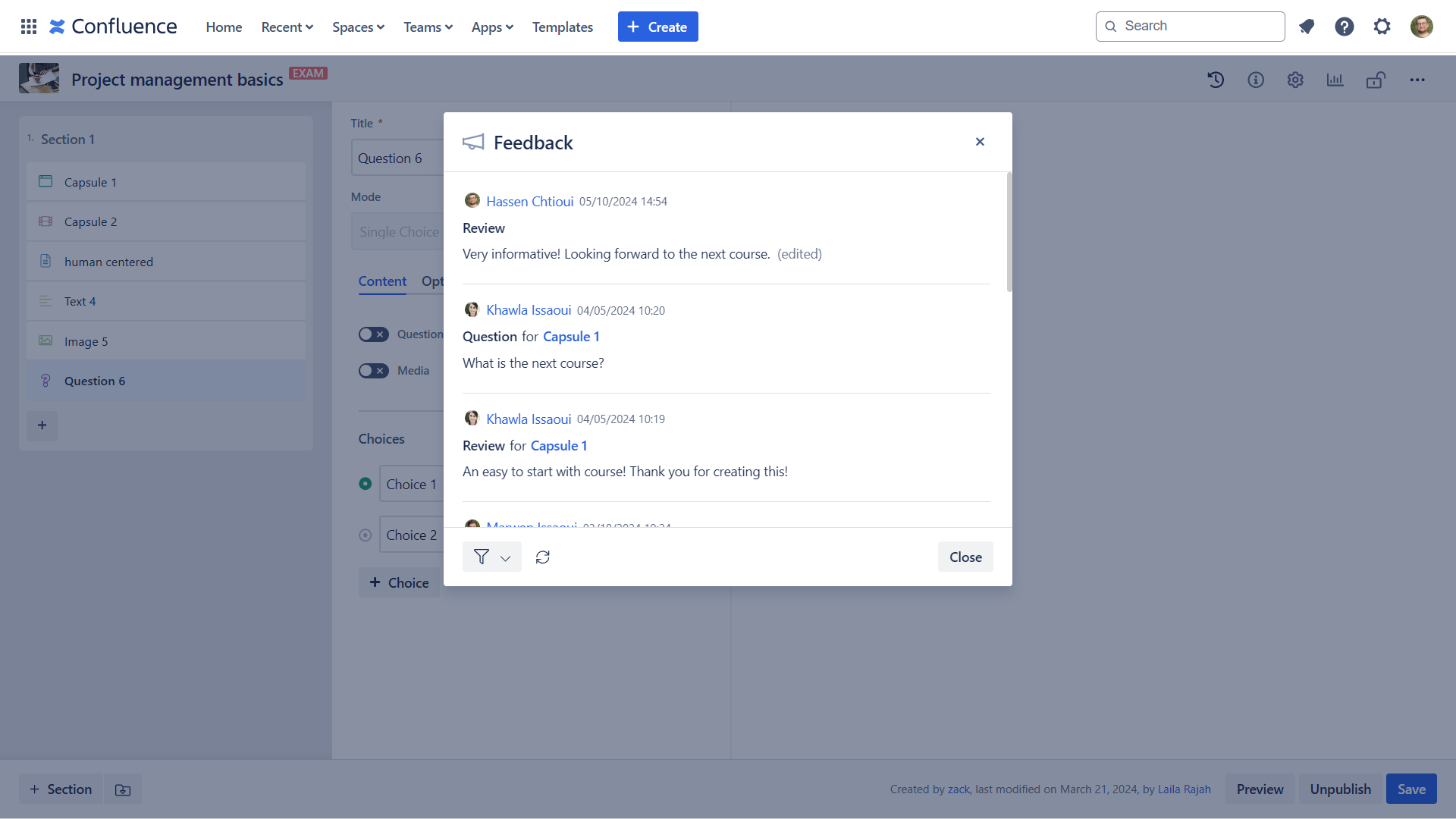
Assign
New assignment
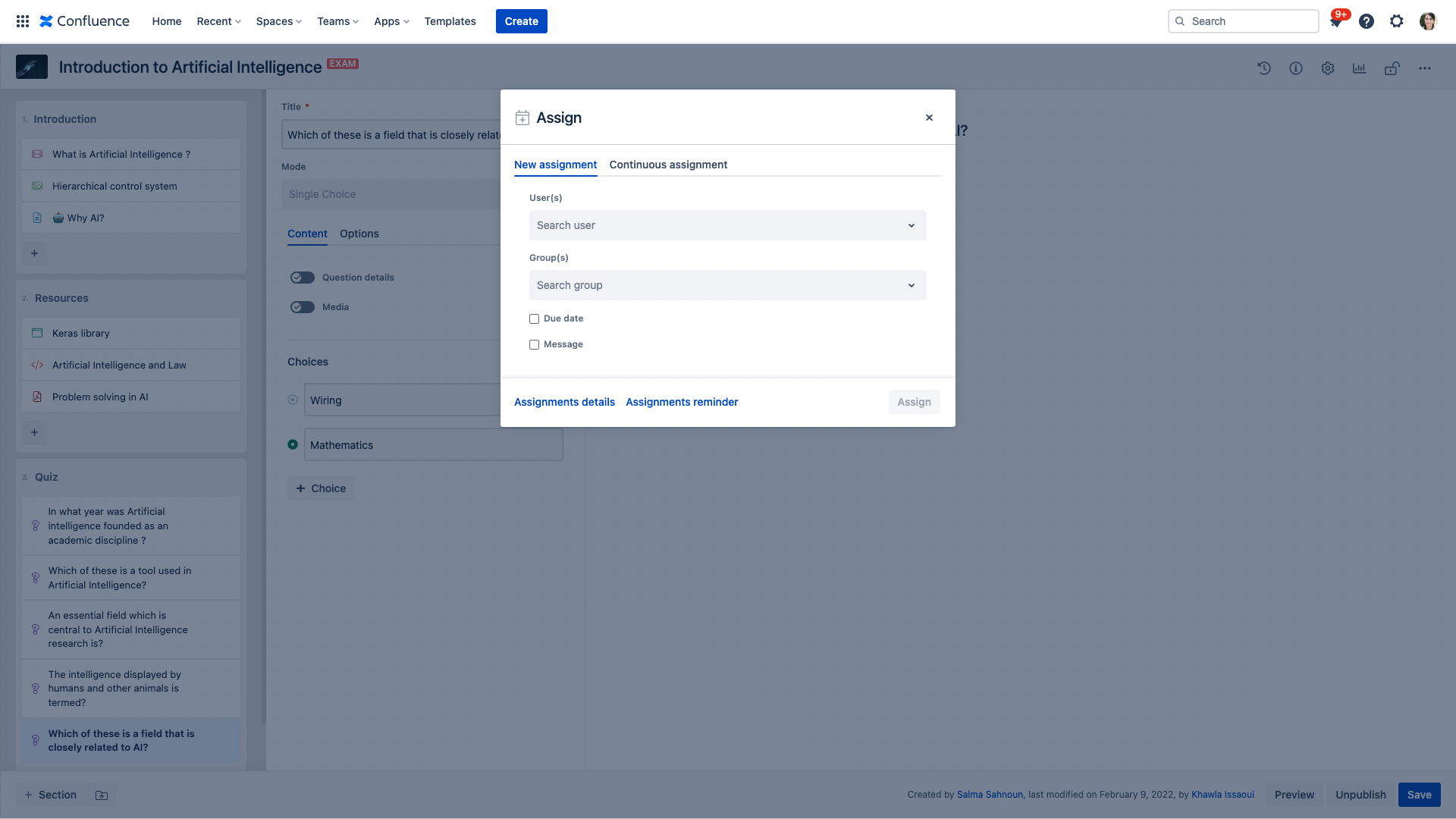
Assigned users or groups need to complete the course.
Course assignment involves:
- Assigned users or groups of users will receive assignment notifications
- Users will find the assigned course in the Assigned tab of the Course catalog
- A special Assigned tag will be added to the user session in the course insights
- The list of the assigned courses is displayed in the users' course dashboard
If a Due date is enabled :
- Assigned users and/or groups will have to complete the course before this date. If not completed, a reminder is sent, for example, once per day for the five days preceding the due date
- If an assigned course is overdue, users are no longer able to view the course unless a course administrator extends the assignment
Continuous assignment

You can schedule an assignment based on groups.
The course will be automatically assigned to users once they join the group.
The scheduled assignment involves:
- Groups: groups to whom the course is assigned
- Due date: course creator can indicate the due date: the number of days after the new user joins the group
- Message: customized message will be sent to the learners along with the notification
When scheduling a continuous assignment, you can enable these options:
- Update existing assignments: Current group members' assignments will be updated
- Only notify future assignments: Current group members will be assigned but will not be notified. Future group members will be assigned and notified.
Current group members who are not assigned to the course will be assigned immediately.
Export SCORM
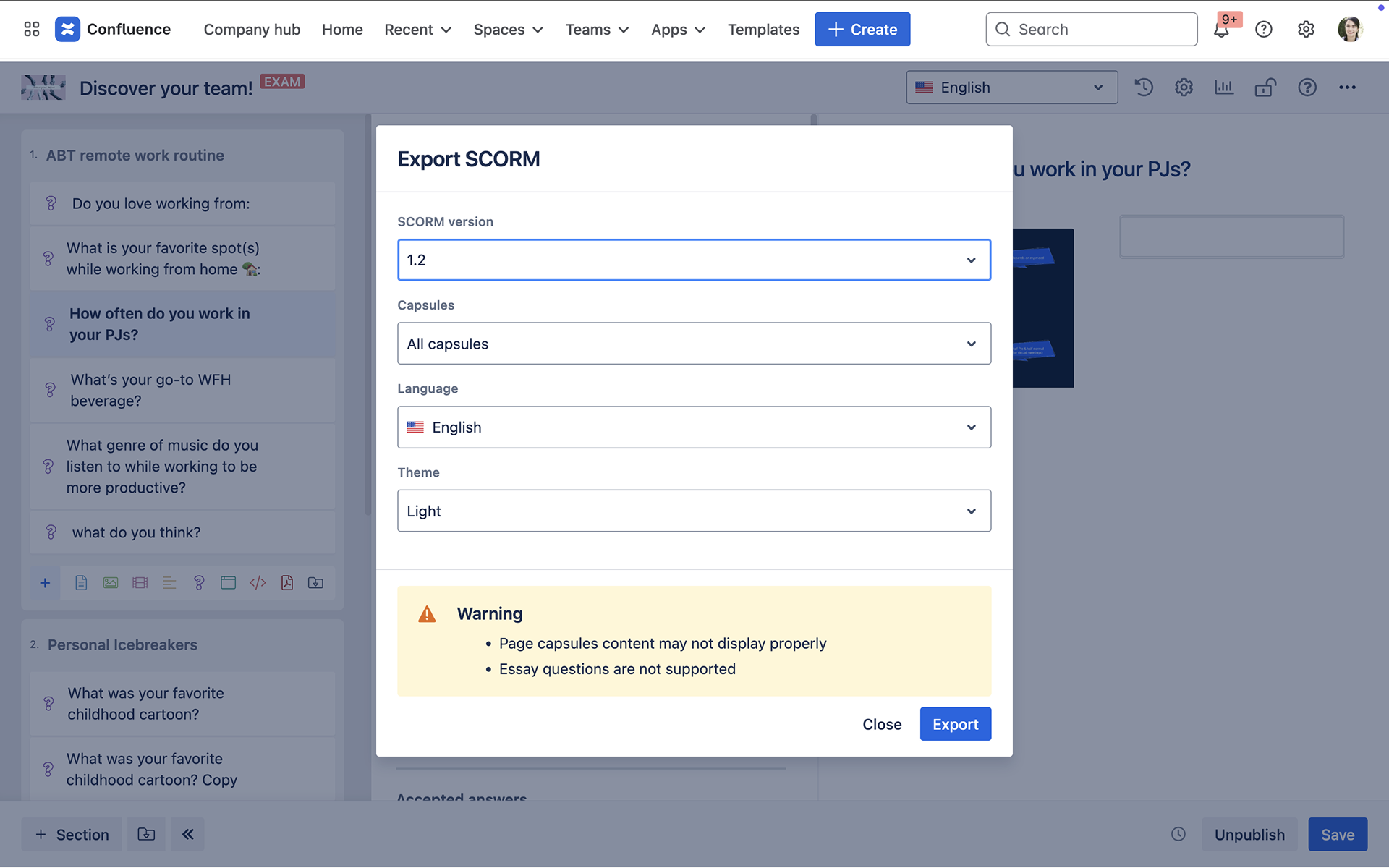
Courses can now be exported as SCORM files right from the course editor. Select the SCORM version, the components that will be included in the export and the theme. For multi-language courses, you will also have to select one language to export the course in.
Export SCORM does not support the following features:
- Essay mode question components
- PDF components using links
- Exam attempts
- Confluence Questions components
Confluence page macros and formatting are not fully supported and their content can be displayed differently. Please check the final page form after it's exported.
To maintain more accurate Confluence page designs, we recommend exporting the page in PDF format and uploading it in the course as a PDF component to be exported.
Exported courses maintain the following insights and configuration after upload:
- Insights:
- For exported regular courses, the SCORM score will display the question success rate
- For exported exams, the SCORM score will display the exam score
- Course configuration:
- Question options
- Minimum pass score
- Forced sequential navigation
- Custom message
Manage Attachments

When deleting a component, the attachment is not removed from Smart Courses. Attachments can be managed in different ways.
The table has three columns:
- Title: Attachment label stored in Confluence
- Used in: List of components where the Attachment is used
- Delete: Allows you to delete the attachment if it is not used in any component
When adding attachments to course components, if an existing attachment with the same name is uploaded, Smart Courses creates a copy and adds a unique suffix "-cvsXXXXXX" to the file's name to avoid overwriting used attachments in other components.
Certification

A course editor can enable certificate generation once the learners finish their course.
You can easily customize your certificate using a combination of HTML and Thymeleaf code while having a live preview of the changes you made.
Here is the list of the pre-defined variables:
Course title
Author name
learners' name
Completion date
Score
Result
Certificate template actions:
- Restore the default global template or the default space template if enabled.
- Refresh certificate preview.
Certification options:
Enable Certification: Learners will be provided with a download link for a PDF version of the certificate once:
- A regular course is completed: has a 100% session progress
- An exam is finished: Learners need to click the finish button
- A SCORM is completed: session status is completed
Only when PASS: Deliver certificate only for successful learners.
Only following fonts are supported:
Arial
Comic Sans MS
Courier New
Garamond
Georgia
Impact
Tahoma
Times New Roman / Times
Trebuchet MS
Verdana
Make sure to respect the following font paths:
For Windows : windir/fonts
For Linux :
/usr/share/X11/fonts
/usr/X/lib/X11/fonts
/usr/openwin/lib/X11/font
/usr/X11R6/lib/X11/fonts
/usr/share/fonts
These fonts are only supported for Cloud deployment. For on-premise deployment, If you are trying to display or render text and notice that fonts are missing, it may be an indication that you need to install the necessary fonts.
Completion date formatting:
The completion date is by default inserted in the certificate using the following line of code: <div th:text="${completionDate}"></div>
This gives the following completion date format example: Fri May 12 12:51:45 UTC 2023
The course completion date and time format can be further customized in the following ways :
Completion date and time pattern | Result |
|---|---|
| |
| |
| |
| |
The most commonly used symbols for completion date formatting are in the following table:
Letter | Date or Time Component | Presentation | Examples |
|---|---|---|---|
y | Year | Year | 2023; 23 |
M | Month in year | Month | July; Jul; 07 |
d | Day in month | Number | 10 |
E | Day name in week | Text | Tuesday; Tue |
a | Am/pm marker | Text | PM |
H | Hour in day (0-23) | Number | 0 |
h | Hour in am/pm (1-12) | Number | 12 |
m | Minute in hour | Number | 30 |
s | Second in minute | Number | 55 |
S | Millisecond | Number | 978 |
z | Time zone | General time zone | Coordinated Universal Time; UTC |
Check this link for more completion date formatting examples.
Images should be encoded in base64 format and directly inserted in the HTML code.
The certificate template colors do not support opacity variables.
Contributors

A course admin can select users to grant them the right to edit the course (contributors).
Smart Courses distinguishes the course administrator from contributors. A course administrator is either the course creator, a space admin, a Confluence admin, or a Smart Courses admin.
Course contributors cannot:
- Edit course contributors list
- Manage advanced settings related to exam mode, questions, sequential navigation, custom message, comments, enrollment and course assignment reminders.
- Manage restrictions
- Copy, move or delete a course.
You can add up to 100 individual users to the contributors list.
Copy

Copy a course to another space. The visibility rights of the target space will apply to the course copy.
When you copy a course, the following elements are not copied:
- Restrictions
- Contributors
Note that it is only possible to copy a course to another space if the editor has course creation rights.
Move [Only On-premise]

Move a course to another space. The visibility rights of the target space will apply to the moved course.
Note that it is only possible to move a course to another space if the editor has course creation rights.
Delete
Allows you to delete the course.
Please note that deleting a course is an irreversible action. All the data and learners' sessions related to the course will be deleted.
Concurrent editing prevention [Cloud]
When one contributor is editing the course, all other contributors cannot edit or configure it simultaneously. A yellow bar on the top will appear, informing you that the course is currently locked for editing. This is a precaution to prevent conflicts and ensure changes are managed efficiently. Once the current contributor finishes editing, other contributors will need to refresh to edit the course.
Check this FAQ link for more details.
